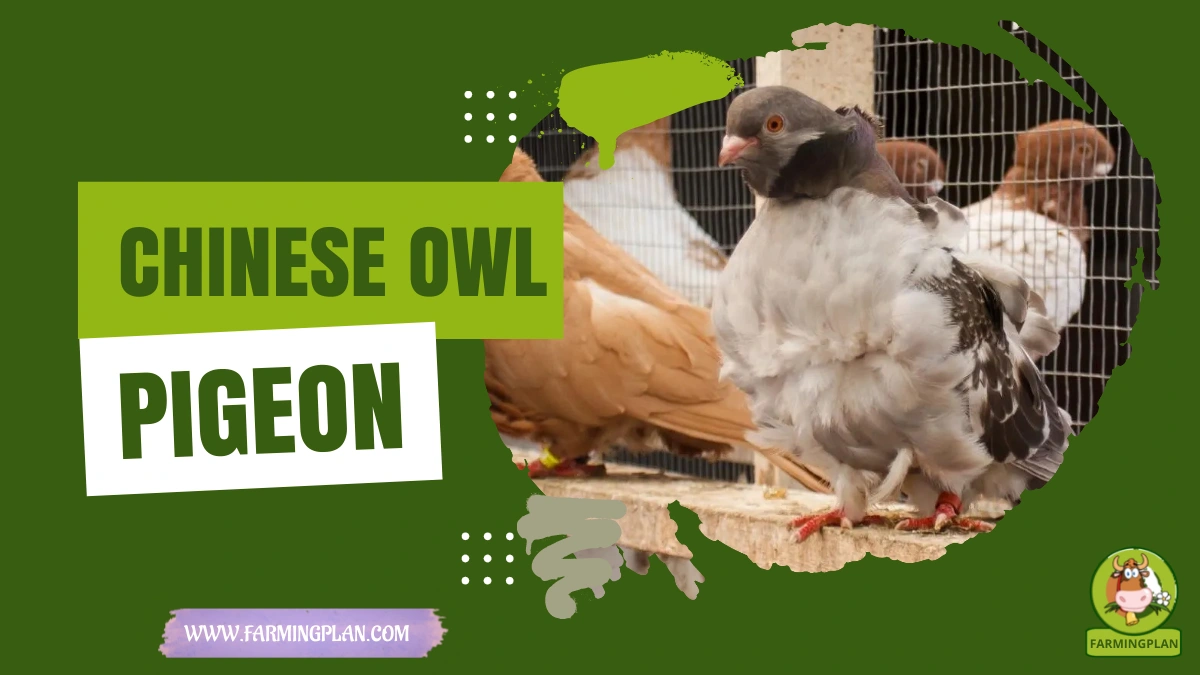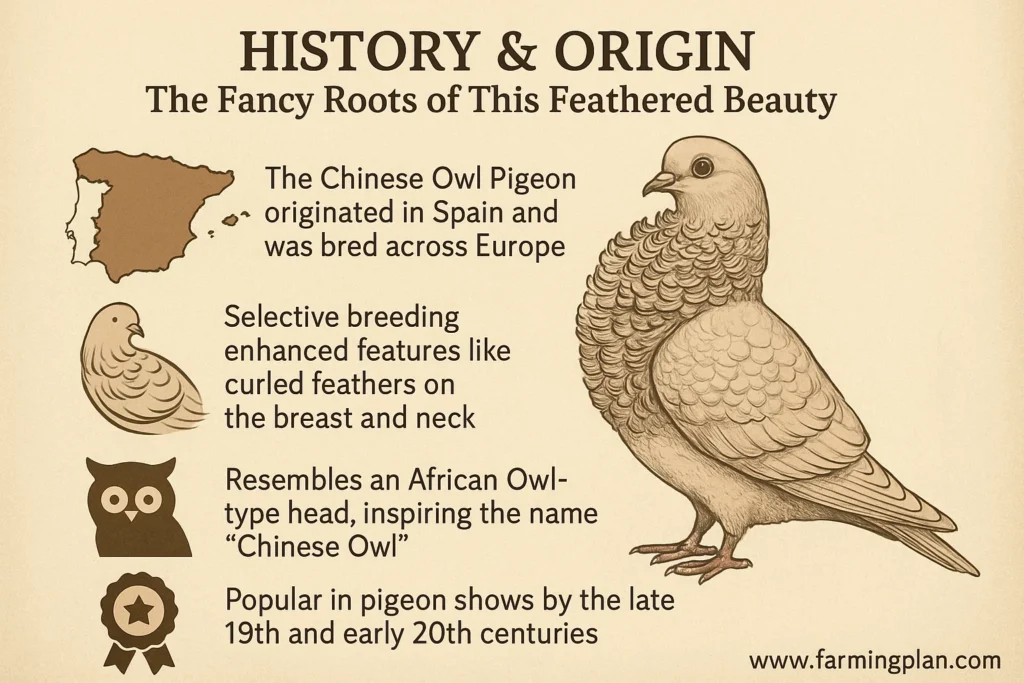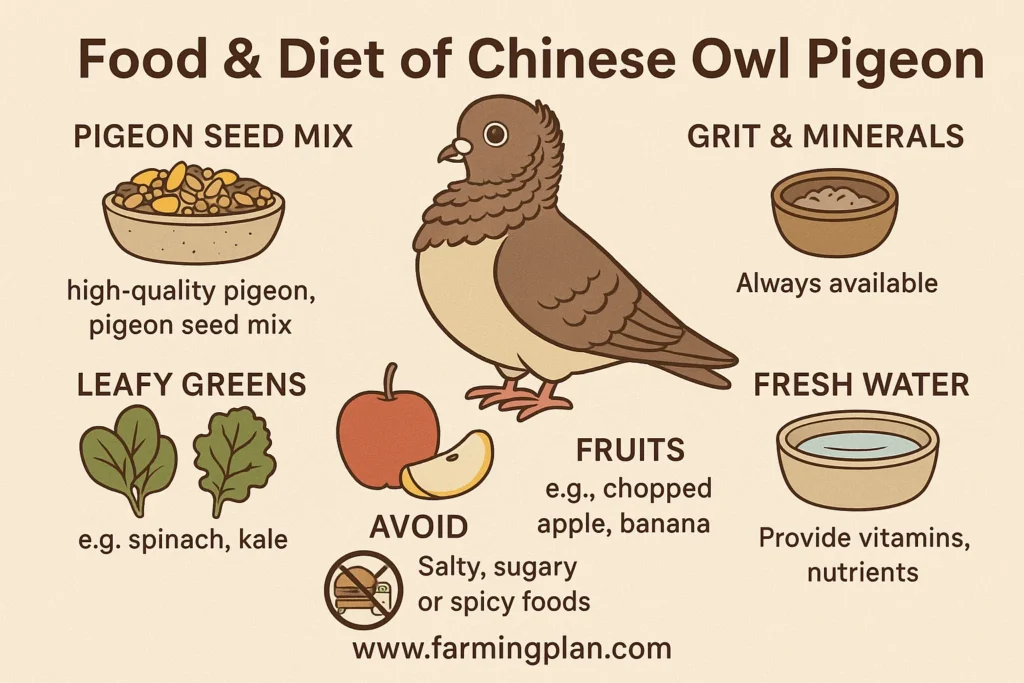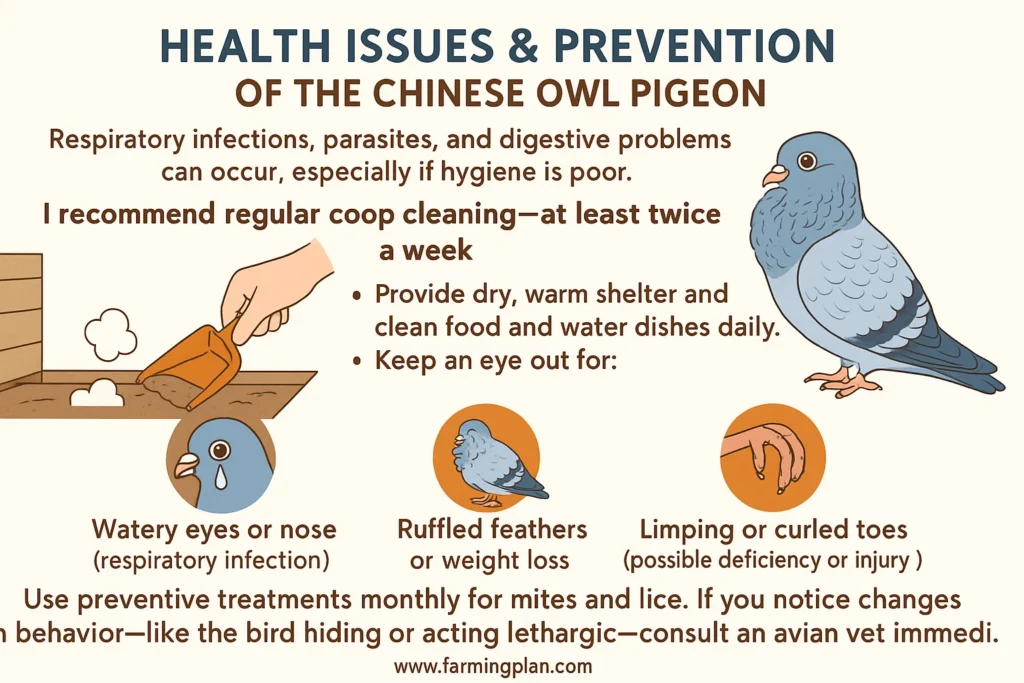The Chinese Owl Pigeon is a real showstopper in the world of fancy pigeon breeds. With its frilled feathers, compact build, and sweet personality, it’s no wonder so many bird lovers fall head over heels for this breed. I’ve personally raised a few of these charmers, and let me tell you—they’re as friendly as they are beautiful. This breed isn’t just a pretty face either. From their smooth, rounded head to their tightly curled breast frill and elegant feather formations, they’re a living piece of art. Whether you’re looking for a docile pet, a competitive show bird, or just something to brighten your loft, the Chinese Owl Pigeon is a perfect pick.

History & Origin of Chinese Owl Pigeon
The Chinese Owl Pigeon has quite a misleading name—it didn’t actually come from China! Most historians believe this breed originated in Spain and was selectively bred across Europe for its unique feather traits. Over time, its popularity grew among pigeon fanciers, especially for its frilled feathers and compact structure.
Breeders focused on enhancing specific features—like the curled feathers around the breast and neck—through generations of selective breeding. Eventually, the breed became known as the Chinese Owl, possibly because of its resemblance to the African Owl-type head but with distinct puff and feather curl patterns.

Despite its name, it shares no direct connection with owl species but certainly embodies their grace. By the late 19th and early 20th centuries, the Chinese Owl was a favorite in pigeon shows around the world. Today, it’s one of the most popular fancy pigeon breeds globally, cherished for its charming appearance and easygoing temperament.
Read More: How To Care For A Sorraia Horse: A Step-By-Step Guide
Characteristics of the Chinese Owl Pigeon
The Chinese Owl Pigeon is a small- to medium-sized bird, usually measuring around 7 to 9 inches from beak to tail. What really sets it apart is the frill of feathers on its chest and neck. These feathers curl outward in a decorative puff, often compared to a fancy collar or ruffled shirt.
The head is round and smooth, following the African Owl-type profile. Their dainty beak sits neatly, giving them a balanced look. Their eye cere is clean and smooth—another requirement for show-quality birds. The wings are strong but held neatly, and the tails are well-set and sometimes show a soft split or tail bar, especially in birds bred for show standards.
Color-wise, these birds come in a variety of color classes including blue check, silver check, white, and even brown T-pattern check. Many breeders aim for a combination of color with bright tone, but there’s also high demand for single color birds. The light horn color toenails and reddish or dark horn beak also contribute to their grading in exhibitions.
Nature/Temperament – Docile Birds With Loads of Personality
From my experience, the Chinese Owl Pigeon is not just friendly, but one of the most amiable pigeon breeds you can raise. They’re calm, curious, and form strong bonds with their human caretakers. These birds are not territorial, making them great for lofts with multiple breeds. They love to interact with people, especially if handled gently from a young age. I’ve had birds that would perch on my shoulder while I cleaned their loft.
Their docile temperament makes them suitable for beginner bird keepers, kids, or hobbyists who enjoy daily interaction. However, don’t mistake their quiet nature for laziness. They’re quite active and alert but prefer grace over chaos. Whether they’re walking around or fluffing their chest feathers, you’ll notice a touch of elegance and grace in everything they do.
Food & Diet of Chinese Owl Pigeon
Feeding a Chinese Owl Pigeon is pretty straightforward. A balanced diet goes a long way in maintaining those gorgeous feathers and their overall health. I like to start with a high-quality pigeon seed mix that includes grains like corn, millet, wheat, and peas. For added nutrition, I offer grit and mineral supplements—this helps with digestion and eggshell quality if you’re breeding.

Fresh fruits like chopped apples or bananas can be offered weekly, and leafy greens such as spinach or kale should be rotated in. Avoid salty, sugary, or spicy foods. No human junk food! Always ensure fresh water is available. Chinese Owls are prone to feather stress if they’re not getting enough nutrients, so be generous with those vitamins.
“Feathers Don’t Make the Bird—But Frills Sure Make the Chinese Owl Shine!”
Usage/Purpose – A Showpiece, Companion, and More
The Chinese Owl Pigeon is mainly raised for show purposes and as a pet. Their visual appeal, size, and friendly behavior make them a top pick in pigeon competitions and exhibitions. Thanks to their manageable size and docile personality, they’re also great for apartment settings or small backyard coops.
Breeders often aim to enhance specific color traits or feather formations, especially the breast and neck frill, to meet official color standards and show requirements. While they’re not typically used for meat or work, they serve a strong purpose in promoting pigeon fancying and hobbyist breeding worldwide.
Read More: Knabstrupper Horse: The Spotted Beauty That Turns Heads Everywhere
Special Features – Traits That Set Them Apart
The Chinese Owl Pigeon is loaded with special features, and some are quite rare:
- Breast Frill & Neck Frill: The signature curled feathers at the front.
- Smooth Profile with Rounded Head: Gives the bird its owl-like appearance.
- Light Checks & T-patterns: Stunning feather patterns seen in show birds.
- Dainty Beak Setting: Adds to the bird’s neat and delicate look.
- Crown Puff: A subtle rise on the top of the head, adding elegance.
- Docility: Among the calmest and easiest breeds to tame.
Their combination of a light horn color, a distinct frill, and graceful stance makes them a profuse display of selective breeding success.
Health Issues & Prevention
These birds are generally hardy, but there are a few health issues to watch for. Respiratory infections, parasites, and digestive problems can occur, especially if hygiene is poor. I recommend regular coop cleaning—at least twice a week. Provide dry, warm shelter and clean food and water dishes daily. Keep an eye out for:

- Watery eyes or nose (respiratory infection)
- Ruffled feathers or weight loss (parasites)
- Limping or curled toes (possible deficiency or injury)
Use preventive treatments monthly for mites and lice. If you notice changes in behavior—like the bird hiding or acting lethargic—consult an avian vet immediately.
Step-by-Step Pet Owner Care Guide – Raise a Happy Chinese Owl
Step 1: Build or Set Up a Proper Loft
The loft should be dry, safe, and well-ventilated. I recommend using a wooden or metal structure with separate nest boxes. Keep enough space—at least 2 sq. ft. per bird. Avoid damp areas to prevent respiratory issues. Line the floor with straw or pine shavings and change bedding weekly. Always place perches at different levels to mimic natural roosting behavior.
Step 2: Feed and Water Daily
Stick to a consistent feeding schedule—once in the morning and once before sunset. Provide a pigeon mix with grains and seeds, and offer clean water in a shallow bowl. Replace the water twice a day in summer. Add grit and crushed oyster shells to help with digestion and calcium needs. Vitamin drops in water once a week help keep the feather frill healthy and strong.
Step 3: Monitor Health and Grooming
Check your bird weekly for signs of illness—dull feathers, odd poop, or discharge from eyes. Trim toenails with care if they get too long. Avoid excessive trimming of wing feathers unless necessary for flight control in shows. Brush loose or frilled feathers gently to avoid tangling. Inspect for lice or mites and treat with vet-approved powder monthly.
Step 4: Encourage Socialization
Chinese Owl Pigeons are not territorial birds. Let them interact with humans and other pigeons early. Offer hand-feeding, soft handling, and time outside the loft in a secured area. A mirror or toy perch can also prevent bird boredom or bird autism-like behaviors from isolation.
Expert Tips & Best Practices – For a Winning Loft
- Start with 3–18 month old birds for easier bonding.
- Choose a white Chinese Owl Pigeon if you want a show-stopper.
- Never overcrowd the loft—stress ruins feather quality.
- Use shade cloths to protect darker birds from sun damage.
- Avoid loud environments; they prefer calm, quiet spaces.
- Separate shield-feathered birds from rougher breeds.
- Observe color patterns like closed check, blue check, or khaki T-pattern check for show prospects.
Tip: “Happy Birds = Healthy Feathers! A quiet coop, clean water, and lots of love keep those frills puffed and proud.”
FAQs
Is the Chinese Owl Pigeon good for beginners?
Yes, its calm nature and small size make it perfect for new bird owners or young hobbyists.
What is the price of a Chinese Owl Pigeon?
Prices range from $40 to $150 depending on color, age, and show quality.
Are Chinese Owl Pigeons noisy?
No, they are one of the quieter fancy breeds and rarely coo loudly.
How do I know if my pigeon has the right feather frill?
A quality frill curls outward across the chest and doesn’t hang loosely or fall to one side.
Can I keep Chinese Owl Pigeons in an apartment?
Yes, if you provide a clean, well-ventilated cage and allow regular flying time in a secure area.
Conclusion
Raising Chinese Owl Pigeons has been one of the most rewarding experiences in my bird-keeping journey. These elegant, frill-feathered birds bring beauty, calm, and joy into any loft. With their easy-going nature, colorful varieties, and show-winning looks, they’re ideal for beginners and seasoned breeders alike. From feeding and grooming to bonding and showing, this breed offers the perfect blend of charm and manageability. If you’re thinking about starting a pigeon loft or adding something truly unique to your aviary, I highly recommend bringing home a Chinese Owl Pigeon. Trust me—once you see that signature frill, you’ll be hooked.
Ready to raise your own feathery friend? Drop your questions below or share your experience—I’d love to hear about your Chinese Owl adventures!
